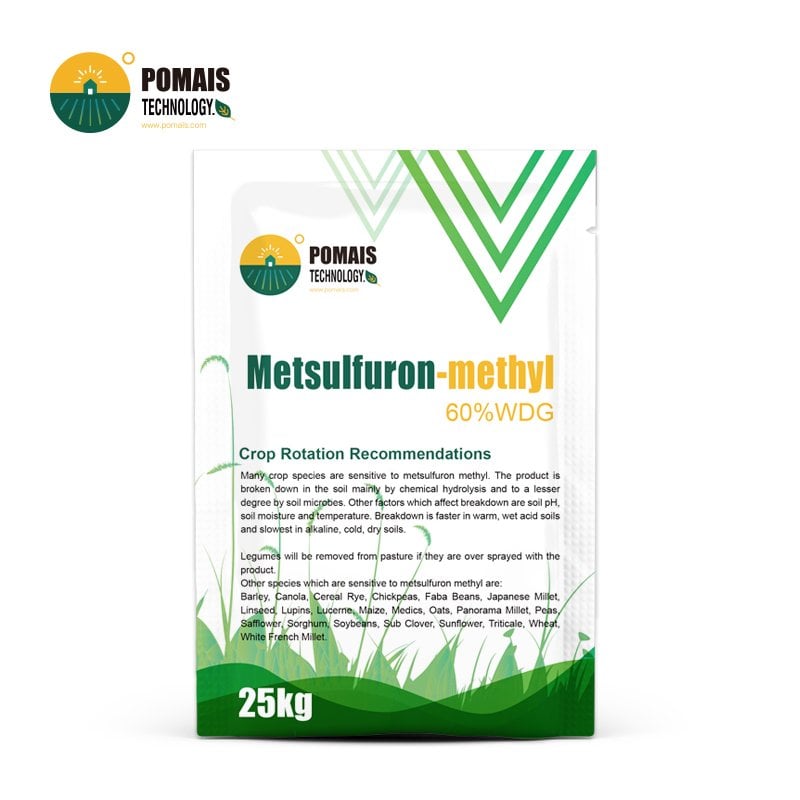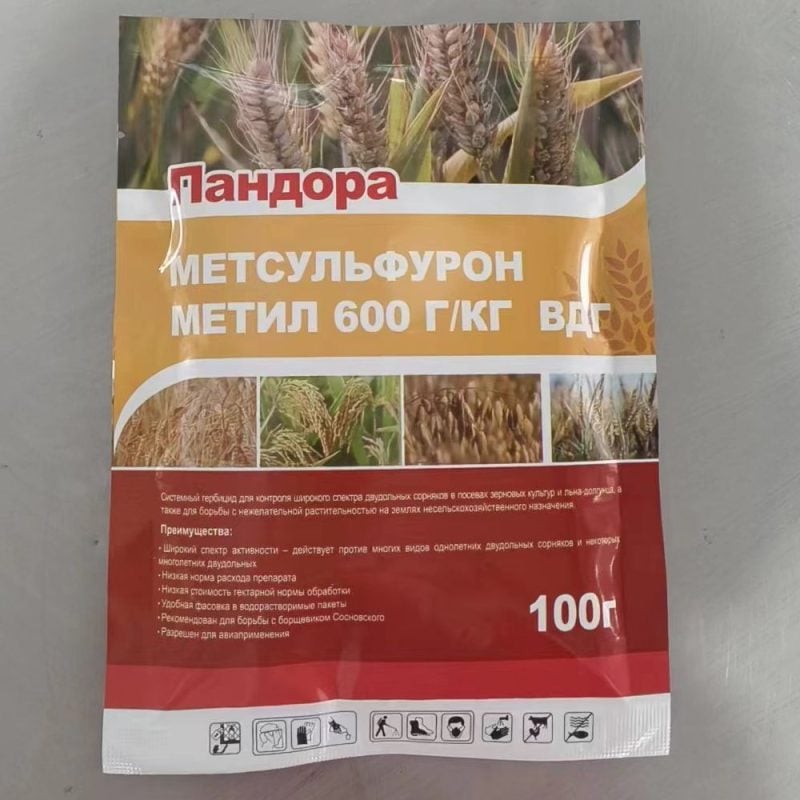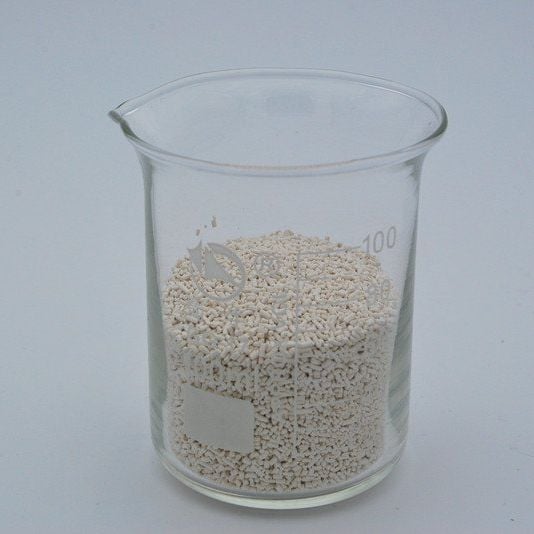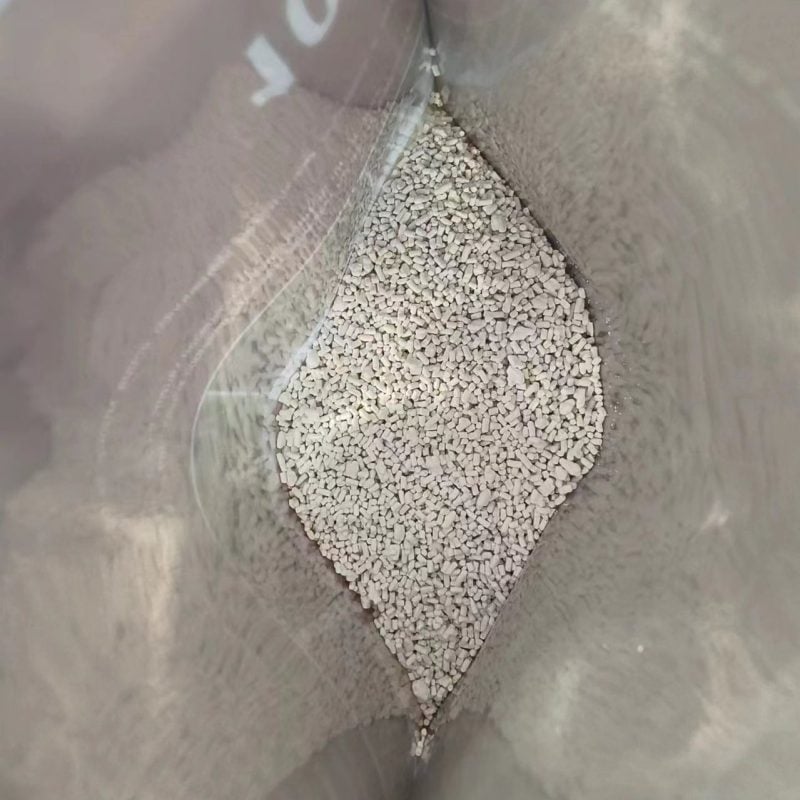Mixing Dicamba or 2,4-D with Metsulfuron Methyl
Combining different herbicides, such as Dicamba, 2,4-D, and Metsulfuron Methyl, is often done to broaden the weed control spectrum and improve the efficacy of post-emergent herbicide applications. However, when mixing herbicides, it’s important to consider their selectivity, mode of action, compatibility, and any potential crop damage.
We can mix different pesticides, both dosage content packaging can be done according to customer requirements, and before mass production will be configured samples to the customer to finalize, if your country and market is being affected by resistance, please use this mixture, please feel free to contact us!
Dicamba (3,6-Dichloro-2-methoxybenzoic acid)
Dicamba is a broad-spectrum, selective herbicide, effective in controlling broadleaf weeds. It works by mimicking plant growth hormones (auxins) and causing rapid, uncontrolled growth that eventually leads to plant death.
- Mode of Action: Similar to 2,4-D, Dicamba mimics auxin (plant hormone), which disrupts normal plant growth, particularly in broadleaf weeds.
- Common Uses: Widely used in pastures, cereals, and lawns, and also as part of herbicide-resistant crop systems (e.g., Dicamba-resistant soybeans).
- Environmental Impact: High volatility, which increases the risk of drift, potentially damaging non-target crops. Dicamba is prone to movement under certain weather conditions, making its application timing crucial.
2,4-D (2,4-Dichlorophenoxyacetic Acid)
As mentioned earlier, 2,4-D is a selective herbicide targeting broadleaf weeds. It is often used in combination with other herbicides to enhance weed control effectiveness.
- Mode of Action: Mimics plant hormones (auxins) leading to uncontrolled growth in broadleaf weeds, similar to Dicamba.
- Common Uses: Often used in combination with other herbicides to improve control of broadleaf weeds in crops like wheat, corn, and rice.
- Environmental Impact: Moderate risk of drift, but less volatile than Dicamba.
Metsulfuron Methyl
Metsulfuron Methyl, as part of the sulfonylurea herbicide family, has a different mode of action compared to Dicamba and 2,4-D, as it inhibits the ALS enzyme responsible for amino acid synthesis in plants.
- Mode of Action: Inhibits acetolactate synthase (ALS), stopping amino acid synthesis and preventing plant growth.
- Common Uses: Effective against broadleaf weeds and some grass species, often applied in cereals, pastures, and industrial areas.
- Environmental Impact: Long persistence in soil can affect sensitive crops that are planted afterward, requiring careful planning of crop rotation.
Mixing Dicamba or 2,4-D with Metsulfuron Methyl
Mixing Dicamba or 2,4-D with Metsulfuron Methyl can create an effective herbicide combination, offering broad-spectrum control of various weeds, particularly those resistant to single-mode herbicides. Both combinations have distinct features and challenges.
Mixing Dicamba and Metsulfuron Methyl
When Dicamba is mixed with Metsulfuron Methyl, the combination targets a broad range of broadleaf weeds and some grass species. This mix is especially effective in agricultural settings like cereals and pastures, where resistance management is crucial.
- Weed Control Spectrum: Dicamba targets broadleaf weeds, while Metsulfuron Methyl adds control over both broadleaf weeds and some grass species.
- Mode of Action: Dicamba mimics the plant hormone auxin, causing rapid, uncontrolled growth in weeds. Metsulfuron Methyl inhibits the ALS enzyme, which disrupts essential amino acid production.
- Key Advantages:
- Combining these herbicides broadens the range of susceptible weeds.
- Different modes of action help manage and reduce the risk of herbicide resistance.
- Challenges:
- Dicamba is known for its high volatility and drift potential, especially under unfavorable weather conditions, which can affect sensitive neighboring crops. Special care in application is needed to minimize this risk.
- Metsulfuron Methyl’s persistence in the soil may limit crop rotation options after application.
Mixing 2,4-D and Metsulfuron Methyl
The combination of 2,4-D with Metsulfuron Methyl also targets a wide range of broadleaf weeds, especially in crops like cereals and pastures. It is a commonly used mixture in agricultural settings to control weeds that are resistant to a single herbicide.
- Weed Control Spectrum: Similar to Dicamba, 2,4-D focuses on broadleaf weeds, while Metsulfuron Methyl extends the control to both broadleaf weeds and some grass species.
- Mode of Action: 2,4-D works by mimicking auxins, disrupting normal plant growth. Metsulfuron Methyl inhibits ALS, leading to the stoppage of amino acid synthesis and, ultimately, plant death.
- Key Advantages:
- 2,4-D has a lower volatility compared to Dicamba, making it slightly easier to manage in terms of drift.
- The combination offers effective control over a wide range of weeds while minimizing the risk of developing herbicide-resistant strains.
- Challenges:
- Although less volatile than Dicamba, 2,4-D can still drift under certain conditions, requiring careful application.
- Like with Dicamba, the soil persistence of Metsulfuron Methyl may impact subsequent planting of sensitive crops.
Considerations for Mixing Dicamba or 2,4-D with Metsulfuron Methyl
- Broad Weed Control: Both mixtures effectively control a broad spectrum of weeds, combining auxin mimics (Dicamba or 2,4-D) with ALS inhibitors (Metsulfuron Methyl). This makes them useful in cereals, pastures, and other agricultural applications.
- Resistance Management: The combination of these two different modes of action helps prevent herbicide resistance, which is increasingly common with the overuse of single-mode herbicides.
- Drift Risk:
- Dicamba: Known for high volatility and drift, especially under hot and windy conditions. This can damage nearby sensitive crops, like soybeans and vegetables.
- 2,4-D: Lower volatility than Dicamba, but still requires careful handling to prevent drift.
- Soil Persistence: Metsulfuron Methyl has a longer persistence in the soil, which may restrict the planting of sensitive crops in the treated area.
- Application Flexibility: Both mixtures are effective as post-emergent herbicides, meaning they target weeds that have already germinated and are actively growing. This flexibility makes them suitable for various agricultural settings.
Dicamba or 2,4-D with Metsulfuron Methyl : Summary Table
| Feature | Dicamba + Metsulfuron Methyl | 2,4-D + Metsulfuron Methyl |
|---|---|---|
| Weed Spectrum | Broadleaf + some grass species | Broadleaf + some grass species |
| Mode of Action | Auxin mimic + ALS enzyme inhibitor | Auxin mimic + ALS enzyme inhibitor |
| Volatility/Drift | High (Dicamba) | Moderate (2,4-D) |
| Environmental Persistence | Metsulfuron Methyl: long persistence | Metsulfuron Methyl: long persistence |
| Resistance Management | Reduces risk of resistance | Reduces risk of resistance |
| Effect on Sensitive Crops | High risk due to drift | Lower risk compared to Dicamba |
| Primary Use | Broadleaf weed control in cereals, pastures | Broadleaf weed control in cereals, pastures |
Conclusion
Mixing Dicamba or 2,4-D with Metsulfuron Methyl is a powerful tool for broadleaf weed control in agricultural settings. While both combinations offer advantages in terms of weed spectrum and resistance management, Dicamba’s higher volatility requires more caution in application compared to 2,4-D. Metsulfuron Methyl’s long soil persistence should also be considered when planning crop rotations.
Combining different herbicides, such as Dicamba, 2,4-D, and Metsulfuron Methyl, is often done to broaden the weed control spectrum and improve the efficacy of post-emergent herbicide applications. However, when mixing herbicides, it’s important to consider their selectivity, mode of action, compatibility, and any potential crop damage.
We can mix different pesticides, both dosage content packaging can be done according to customer requirements, and before mass production will be configured samples to the customer to finalize, if your country and market is being affected by resistance, please use this mixture, please feel free to contact us!
Dicamba (3,6-Dichloro-2-methoxybenzoic acid)
Dicamba is a broad-spectrum, selective herbicide, effective in controlling broadleaf weeds. It works by mimicking plant growth hormones (auxins) and causing rapid, uncontrolled growth that eventually leads to plant death.
- Mode of Action: Similar to 2,4-D, Dicamba mimics auxin (plant hormone), which disrupts normal plant growth, particularly in broadleaf weeds.
- Common Uses: Widely used in pastures, cereals, and lawns, and also as part of herbicide-resistant crop systems (e.g., Dicamba-resistant soybeans).
- Environmental Impact: High volatility, which increases the risk of drift, potentially damaging non-target crops. Dicamba is prone to movement under certain weather conditions, making its application timing crucial.
2,4-D (2,4-Dichlorophenoxyacetic Acid)
As mentioned earlier, 2,4-D is a selective herbicide targeting broadleaf weeds. It is often used in combination with other herbicides to enhance weed control effectiveness.
- Mode of Action: Mimics plant hormones (auxins) leading to uncontrolled growth in broadleaf weeds, similar to Dicamba.
- Common Uses: Often used in combination with other herbicides to improve control of broadleaf weeds in crops like wheat, corn, and rice.
- Environmental Impact: Moderate risk of drift, but less volatile than Dicamba.
Metsulfuron Methyl
Metsulfuron Methyl, as part of the sulfonylurea herbicide family, has a different mode of action compared to Dicamba and 2,4-D, as it inhibits the ALS enzyme responsible for amino acid synthesis in plants.
- Mode of Action: Inhibits acetolactate synthase (ALS), stopping amino acid synthesis and preventing plant growth.
- Common Uses: Effective against broadleaf weeds and some grass species, often applied in cereals, pastures, and industrial areas.
- Environmental Impact: Long persistence in soil can affect sensitive crops that are planted afterward, requiring careful planning of crop rotation.
Mixing Dicamba or 2,4-D with Metsulfuron Methyl
Mixing Dicamba or 2,4-D with Metsulfuron Methyl can create an effective herbicide combination, offering broad-spectrum control of various weeds, particularly those resistant to single-mode herbicides. Both combinations have distinct features and challenges.
Mixing Dicamba and Metsulfuron Methyl
When Dicamba is mixed with Metsulfuron Methyl, the combination targets a broad range of broadleaf weeds and some grass species. This mix is especially effective in agricultural settings like cereals and pastures, where resistance management is crucial.
- Weed Control Spectrum: Dicamba targets broadleaf weeds, while Metsulfuron Methyl adds control over both broadleaf weeds and some grass species.
- Mode of Action: Dicamba mimics the plant hormone auxin, causing rapid, uncontrolled growth in weeds. Metsulfuron Methyl inhibits the ALS enzyme, which disrupts essential amino acid production.
- Key Advantages:
- Combining these herbicides broadens the range of susceptible weeds.
- Different modes of action help manage and reduce the risk of herbicide resistance.
- Challenges:
- Dicamba is known for its high volatility and drift potential, especially under unfavorable weather conditions, which can affect sensitive neighboring crops. Special care in application is needed to minimize this risk.
- Metsulfuron Methyl’s persistence in the soil may limit crop rotation options after application.
Mixing 2,4-D and Metsulfuron Methyl
The combination of 2,4-D with Metsulfuron Methyl also targets a wide range of broadleaf weeds, especially in crops like cereals and pastures. It is a commonly used mixture in agricultural settings to control weeds that are resistant to a single herbicide.
- Weed Control Spectrum: Similar to Dicamba, 2,4-D focuses on broadleaf weeds, while Metsulfuron Methyl extends the control to both broadleaf weeds and some grass species.
- Mode of Action: 2,4-D works by mimicking auxins, disrupting normal plant growth. Metsulfuron Methyl inhibits ALS, leading to the stoppage of amino acid synthesis and, ultimately, plant death.
- Key Advantages:
- 2,4-D has a lower volatility compared to Dicamba, making it slightly easier to manage in terms of drift.
- The combination offers effective control over a wide range of weeds while minimizing the risk of developing herbicide-resistant strains.
- Challenges:
- Although less volatile than Dicamba, 2,4-D can still drift under certain conditions, requiring careful application.
- Like with Dicamba, the soil persistence of Metsulfuron Methyl may impact subsequent planting of sensitive crops.
Considerations for Mixing Dicamba or 2,4-D with Metsulfuron Methyl
- Broad Weed Control: Both mixtures effectively control a broad spectrum of weeds, combining auxin mimics (Dicamba or 2,4-D) with ALS inhibitors (Metsulfuron Methyl). This makes them useful in cereals, pastures, and other agricultural applications.
- Resistance Management: The combination of these two different modes of action helps prevent herbicide resistance, which is increasingly common with the overuse of single-mode herbicides.
- Drift Risk:
- Dicamba: Known for high volatility and drift, especially under hot and windy conditions. This can damage nearby sensitive crops, like soybeans and vegetables.
- 2,4-D: Lower volatility than Dicamba, but still requires careful handling to prevent drift.
- Soil Persistence: Metsulfuron Methyl has a longer persistence in the soil, which may restrict the planting of sensitive crops in the treated area.
- Application Flexibility: Both mixtures are effective as post-emergent herbicides, meaning they target weeds that have already germinated and are actively growing. This flexibility makes them suitable for various agricultural settings.
Dicamba or 2,4-D with Metsulfuron Methyl : Summary Table
| Feature | Dicamba + Metsulfuron Methyl | 2,4-D + Metsulfuron Methyl |
|---|---|---|
| Weed Spectrum | Broadleaf + some grass species | Broadleaf + some grass species |
| Mode of Action | Auxin mimic + ALS enzyme inhibitor | Auxin mimic + ALS enzyme inhibitor |
| Volatility/Drift | High (Dicamba) | Moderate (2,4-D) |
| Environmental Persistence | Metsulfuron Methyl: long persistence | Metsulfuron Methyl: long persistence |
| Resistance Management | Reduces risk of resistance | Reduces risk of resistance |
| Effect on Sensitive Crops | High risk due to drift | Lower risk compared to Dicamba |
| Primary Use | Broadleaf weed control in cereals, pastures | Broadleaf weed control in cereals, pastures |
Conclusion
Mixing Dicamba or 2,4-D with Metsulfuron Methyl is a powerful tool for broadleaf weed control in agricultural settings. While both combinations offer advantages in terms of weed spectrum and resistance management, Dicamba’s higher volatility requires more caution in application compared to 2,4-D. Metsulfuron Methyl’s long soil persistence should also be considered when planning crop rotations.







